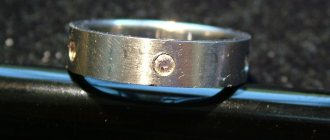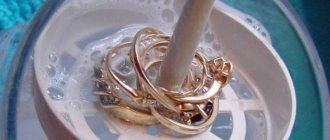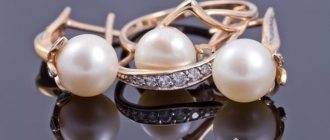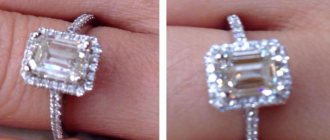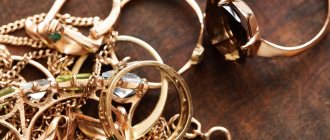Silver is a beautiful noble metal. Products made from it are simply mesmerizing - they shine, shimmer in the light and look like a real work of art. But as soon as you pick up silver or put on jewelry made from it, a rapid oxidation process begins. The metal becomes dull and loses a fair share of its attractiveness.
Therefore, many people prefer to darken silver. On the one hand, such products become like antiques, covered with a layer of patina. On the other hand, shiny silver with dark inclusions looks more attractive.
Relevance of the problem
Silver can be found in almost every home, especially in families where they care about healthy eating, and, therefore, purchase silverware: full-fledged sets or individual cutlery.
Quite quickly after purchase and use, silver items begin to tarnish, turn black and even acquire a greenish tint.
The latter can be noticed even with the most careful handling of these products. The intensity of their use after purchase does not in any way affect their attractive appearance.
Thus, the frequency of use does not affect the degree of blackness of the product surface. The main determining factor in this matter is the metal alloy.
Oxidized and blackened silver: differences
In addition to blackened silver, oxidized noble metal is also available on the market. And it's quite difficult to tell the differences between the two unusual darkening techniques.
You may be interested in: Review of amber jewelry: how to distinguish real amber from a fake?
The principle of creating oxidized silver is based on coating the metal with an oxide film. It creates additional protection for the product from tarnishing, but it does not add quality or durability. After a short period of time after purchase, the item begins to fade. In order for your purchase to leave a pleasant impression, you need to take a close look at the product:
- Oxidized silver has a smooth and only slightly dark surface. Blackened silver is a rich black color that blends harmoniously with light parts.
- The patterns on blackened silver are executed very carefully.
- The cost of blackened silver is much higher than other types of this metal.
- If you clean oxidized silver, white areas will appear on it almost immediately due to friction. Blackened silver is not afraid of polishing and cleaning. Only boiling or exposure to acid can spoil the appearance of such decoration.
Where should I start?
Blackened silver is one of several types of material. Among its other types:
- sterling;
- filigree;
- matte.
When deciding to clean a silver item yourself, you must first decide what specific alloy the items were made from.
This can be done by referring to the documentation included with the purchased items.
If there is a need to clean jewelry with pearls, coral or amber, it is strongly recommended not to do this at home.
The fact is that the listed stones have increased sensitivity to all kinds of alkalis and acids, the presence of which may characterize the product chosen for cleaning.
If you neglect this recommendation, you can very easily spoil the appearance of these stones, and it is unlikely that you will be able to restore the lost attractiveness. The best cleaning option in this case is to contact the services of specialists.
How to clean blackened silver?
Applying dark plaque is much easier than removing it later. In order to get rid of blackening, you will have to make a lot of effort, and most likely you will turn to specialists for help.
But if you need to clean blackened silver while preserving the noble dark coating, then such a procedure will require special care. First of all, you need to give up brushes and use only soft cloths for polishing. This way the relief will remain darkened and the protuberances will remain shiny. Toothpaste can be used as an abrasive. The blackened product cannot be boiled or cleaned with caustic substances.
And in cases where you take a patinated piece of jewelry to a workshop for cleaning, you need to warn the jeweler that you need to preserve the noble patina.
Preparatory work
You can restore the original appearance of other types of products without risk at home. Below are four of the simplest and most accessible methods for each of us.
Before you start cleaning blackened silver using one of these methods, you need to remove all kinds of dirt from the surface of the product: grease and cosmetics, sweat and dust.
And you can do this using:
- dishwashing detergents;
- toothbrush;
- warm water.
In order to properly dilute the detergent in warm water, you can use a glass or ceramic container.
The dish is filled with water, after which the product is immersed there.
To properly clean an item from stubborn dirt, you need to leave the item in the dish for about twenty minutes. You can remove all the dirt well with any soft-bristled brush.
It allows you to completely remove all the most visible gross dirt. After this, the product is washed in warm water.
The first stage of cleaning at home is the same, regardless of which method will be used next.
What is blackening
Most of the items sold as silver in the market are actually blackened silver. In order for the jewelry to acquire a more durable structure and become harder, jewelers use blackening technology. What is silver tarnishing? Mostly copper (or other stronger metals) is added to pure metal.
Domestic craftsmen work with several types of silver - mainly 925. The sample on your jewelry is evidence of the quality of the metal; it indicates the percentage of precious metal and impurities in the alloy. 925 standard means that the jewelry contains 92.5% silver and 7.5% other impurities.
Blackening technology is used to create jewelry:
- ring (ring);
- chain;
- bracelet;
- earrings made of blackened silver, etc.
But that's not all its use. In the 17th century, in addition to earrings and rings with blackened silver, dishes, snuff boxes and engravings began to be produced using this technology. They inked literally everything: from spoons and forks to furniture in the house. Masters of that time depicted paintings and landscapes on silver products using blackening.
Method number 2
It is also recommended to clean blackened silver at home using water and ammonia.
The sequence of steps in this case will be as follows.
If the product is not excessively dirty, but only slightly darkened, then you need to select a small container for cleaning.
Water and ammonia are poured into the bowl in a ratio of 10:1.
A cotton pad or cloth is soaked in the prepared mixture, and then you can clean the item.
For an average degree of contamination, the same product is prepared.
The residence time of the product in the solution in this case is from 15 to 60 minutes. Under no circumstances should you overexpose the item!
Deciding exactly when you can start cleaning is very simple: you just need to monitor the water process.
If the item is excessively dirty, for example, a chain, it should be placed not in the solution, but in pure ammonia. In this case, direct cleaning can begin in a quarter of an hour. Then the chain should be rinsed with water and rubbed with a thick fleecy cloth.
Mechanical
This is the easiest way. To implement this method, you will need graphite mixed with iron oxide and turpentine. The product in the form of a slurry is applied to silver items and wait until completely dry, and then remove the mixture from the surface with a soft brush or suede cloth. Protruding areas are wiped with alcohol. The result is an artificially aged silver product.
Important! This method is used by jewelers to darken a small number of items. If the process is carried out in large quantities, then galvanic baths are used, where metal oxides are deposited on the product by electrolysis. One discharge is created along the perimeter of the container, and another on the alloy. By attracting, plus and minus create the final product.
The disadvantage of the mechanical method is minimal adhesion to the surface of the decoration. Blackened silver rings, necklaces and earrings can be easily returned to their original appearance. Therefore, it is easiest to clean such blackened silver from blackening.
Method number 3
Blackened silver can be perfectly tidied up at home using the following “tools”:
- ammonia;
- dentifrice;
- cotton wool;
- thick napkin.
The container is selected taking into account the size of the product. Ammonia and tooth powder are poured into it - in such proportions that the resulting consistency resembles sour cream.
Cleaning begins by applying the prepared mixture to the surface of the silver item with a disk or cotton ball. As soon as it dries, you can start rubbing the item with a special napkin.
Mechanical method
How to darken silver at home with graphite? This is a fairly simple technology, and its result is due to the same processes that occur with lunar metal over time. That is, dust particles stick to it and firmly “eat” into the recesses. Using graphite you can simply speed up this process.
To blacken the product, they are lubricated with a mixture of graphite powder, iron oxide and turpentine, diluted to a pasty state. Then wait for it to dry completely and wipe the silver with a soft cloth. The older the product, and the more uneven its surface, the more noticeable the result will be. But in general, such blackening is less durable than that obtained by chemical or galvanic methods.
Blackening and oxidation
How to darken silver at home? There are two ways to do this: oxidation and traditional blackening. And the difference between these two methods is colossal.
During oxidation, silver is covered with a thin film of oxides, so the product receives a dark coating. But the coating is short-lived and easily erased. The difference is especially noticeable when cleaning - if you polish oxidized silver, it becomes covered with a network of lighter spots.
Blackening is the coating of a metal surface with a mixture of silver, copper and lead sulfides. This coating is resistant to abrasion and completely disappears only with prolonged boiling or exposure to acid.
Blackening on an industrial scale is carried out in various ways. But, as a rule, they all involve applying a powder from a mixture of silver, copper and lead sulfides to the product. The patina is fixed using the “dry” or “wet method” - in the first case, the product is fired after applying the powder, in the second, the metals are diluted with water to a creamy state, and the silver, after applying the mixture, is heated in a muffle furnace.
If we talk about how to darken silver in general, then experts identify the following methods:
- galvanic - this technology requires the presence of special equipment, so it is not used at home;
- mechanical - using graphite;
- chemical is the most reliable blackening method.
Types of silver alloys
Now on the Russian precious metals market there are several main types of silver alloys: Matte. From the name it is clear that such silver does not reflect and does not have bright patterns; jewelry made from it will not shine in the sun. To obtain a matte surface, various chemicals are added to the metal, due to which the metal slightly changes its properties. It is with the admixture of emulsions that the surface becomes rough rather than smooth, which gives some originality to such products.
- Filigree. As a rule, this option has openwork on the products. The design is made from thin threads, which can be obtained due to the pliability and strength of silver. As a rule, this type of product has a fairly high price tag, due to the complexity of the work, which requires professionalism and skill.
- Sterling (coin). The most common type of silver goods on the Russian market at the moment. These jewels are silver in color, last a long time and shine pleasantly in the light.
- Rhodinated. An expensive method of treating silver with another precious metal belonging to the platinum group. What is rhodium plated silver: the item is coated with a thin layer of rhodium, which gives it strength, scratch resistance, and a “rich” appearance. The irradiated product is often mistaken for white gold due to its noble shine and brightness. Such decorations are considered the best. If the ring is rhodium plated, it will never tarnish or oxidize.
- Blackened silver. Obtained through a sulfur chemical reaction of a metal. Silver with blackening looks like it has aged, darkened from long wear, but this effect is achieved artificially.
We suggest you read How to choose a pillow for sleeping: the best filling, size, height
Chemical method
This is a reliable and durable, and at the same time simple method for blackening silver. Its essence: a silver ring and metal powder from a special mixture are taken and heated together to the required temperature. When exposed to heat, the powder eats into the ring and turns it black. After completing the procedure, the master polishes and grinds the surface of the protruding parts and all necessary parts, making them silver again.
It was this method that has long been used by craftsmen to tarnish silver, creating stunning works that have been preserved for centuries and still stand in some homes. There is no point in talking about the strength and durability of blackening; it is obvious that in this regard, chemical treatment is the best option.
Blackening with an egg
How to darken silver at home with an egg? The technique is quite simple and you do not need to buy any additional funds. Everything you need is already in the refrigerator. So, to blacken with an egg you need to do the following:
- Boil an egg or two if you have a lot of silver jewelry.
- Separate the protein - it can be eaten, as it does not participate in the creation of a noble coating. All the substances needed for blackening are concentrated in the yolk.
- The yolks must be placed in an airtight container and crushed.
- Next, you need to place the silver in the same container, but so that the metal does not touch the yolks, otherwise the blackening process will take place too quickly and unevenly. Therefore, decorations must either be hung or laid out on a wire rack, or, as a last resort, insulated with a paper towel.
- The products should be left with the yolks in a tightly sealed container for a day. If after 24 hours the result does not look very impressive, then you can leave the silver for another 1-2 days.
- Remove the items and wash them with soap.
- Polish all protrusions with a soft cloth.
Sulfuric ointment
You can quickly and effectively darken silver using sulfur ointment. This is a medicine that is mainly used to combat scabies pathogens in both humans and animals. Therefore, it is sold both in veterinary and regular pharmacies.
Sulfur ointment is thick, yellow in color and has a rather unpleasant odor. It must be applied to the product, and then heated to a fluid state using a hairdryer. After the ointment has transformed into a more liquid state, it can be more carefully distributed on the surface of the silver. When heated, you will see how the metal acquires a rich black-blue or purple color. Afterwards, the product can be wiped dry; if necessary, the procedure can be repeated.
Also at home, in order to darken silver, they use “sulfur liver” - a sintered mixture of sulfur and soda, which is thrown into water with silver. But it is not recommended to use this blackening technique at home, since the process will release hydrogen sulfide, a dangerous gas with an unpleasant odor.


